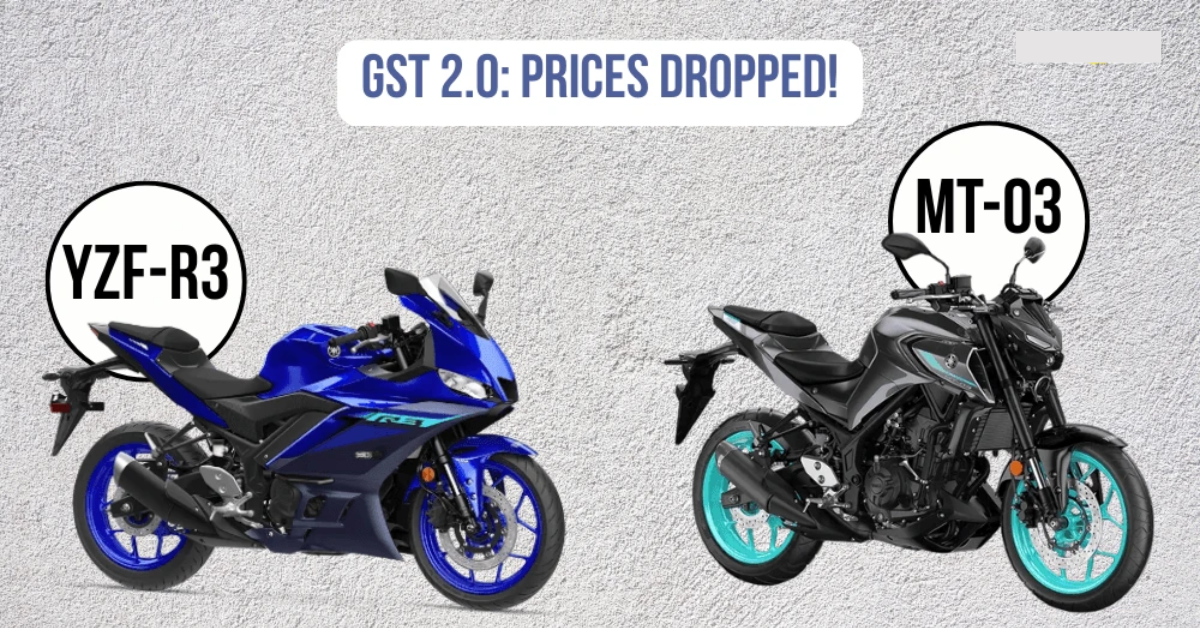The Indian automobile industry is undergoing significant transformation with the introduction of GST 2.0, a revised taxation structure aimed at easing consumer costs and boosting demand. Among the key beneficiaries of this reform are premium two-wheelers, particularly Yamaha’s YZF-R3 and MT-03. Both motorcycles have witnessed a price cut of more than ₹20,000, making them more appealing to enthusiasts who previously considered them slightly overpriced.
This article explores the details of the price revision, key features of the Yamaha YZF-R3 and MT-03, and what this means for buyers in India.
GST 2.0 and Its Impact on Two-Wheeler Prices
The Goods and Services Tax (GST), first implemented in 2017, consolidated multiple indirect taxes into a single system. However, high tax slabs on two-wheelers, especially performance-oriented models, kept them out of reach for many enthusiasts.
With the rollout of GST 2.0, the government has reduced the effective tax burden on mid-capacity motorcycles. The aim is twofold:
- Encourage affordable mobility for young riders and enthusiasts.
- Boost sales of performance motorcycles in India, a market traditionally dominated by commuter bikes.
Yamaha, being a strong player in the premium 300cc category, is among the first to pass on the benefits to its customers.
Yamaha YZF-R3: Sporty Yet Practical
The Yamaha YZF-R3 is a fully-faired sports motorcycle that has earned global recognition for its balance of performance and comfort.
Key Highlights:
- Engine: 321cc, liquid-cooled, parallel-twin engine.
- Power Output: Around 41 bhp and 29.5 Nm of torque.
- Transmission: 6-speed gearbox with assist and slipper clutch.
- Top Speed: Approximately 170–180 km/h.
- Braking & Safety: Dual-channel ABS with front and rear disc brakes.
The R3 is ideal for riders who want a daily-usable sports bike with long-distance touring capabilities. With the GST 2.0 price cut, it becomes a much more lucrative option in the ₹3.3–3.5 lakh segment.
Yamaha MT-03: The Hyper Naked Machine
The Yamaha MT-03 is the naked sibling of the R3, built for those who prefer an aggressive streetfighter look combined with sporty performance.
Key Highlights:
- Engine: Shares the same 321cc twin-cylinder engine as the R3.
- Design: Muscular fuel tank, minimalist headlamp design, and upright riding posture.
- Power & Handling: Offers identical performance figures but with a more city-friendly riding stance.
- Features: Digital instrument console, LED headlamps, and ABS as standard.
Thanks to the lighter build and streetfighter ergonomics, the MT-03 is perfect for city commutes while still being capable of weekend rides and highway stretches.
New Pricing After GST 2.0
With GST 2.0 implemented, both motorcycles have received a price drop exceeding ₹20,000, placing them in a more competitive position.
- Yamaha YZF-R3: Earlier priced around ₹4.65 lakh (ex-showroom), now costs approximately ₹4.45 lakh.
- Yamaha MT-03: Previously priced around ₹4.60 lakh, now reduced to nearly ₹4.40 lakh.
While these numbers may vary slightly depending on the state and dealer, the overall reduction makes these motorcycles more attractive in a segment where value-for-money is a key factor.
Why the Price Drop Matters
For many enthusiasts, a difference of ₹20,000 or more is significant:
- Affordability Boost: Riders who were hesitant due to high pricing now have stronger reasons to consider Yamaha.
- Competitive Edge: Both the R3 and MT-03 directly compete with Kawasaki Ninja 300, KTM RC 390, Honda CBR500R (expected), and BMW G310R. With the new pricing, Yamaha gains an edge in the mid-capacity segment.
- Market Growth: More affordable premium bikes could lead to higher sales volumes, strengthening Yamaha’s presence in India.
Customer Perspective
Enthusiasts have long praised the YZF-R3 for its refined twin-cylinder engine and balanced dynamics. Similarly, the MT-03 has been admired for its urban practicality with sporty DNA. However, pricing has often been a sticking point.
Now, with GST 2.0 reducing the entry barrier, both motorcycles are expected to see a surge in bookings. Riders can now own a globally acclaimed Yamaha machine without stretching their budget as much as before.
Yamaha’s Strategy in India
Yamaha has been focusing on its “Call of the Blue” campaign, highlighting premium products and experiences for enthusiasts. The price drop under GST 2.0 perfectly complements this strategy by:
- Making their premium lineup more accessible.
- Enhancing Yamaha’s appeal among young professionals and college-goers.
- Strengthening brand loyalty in India’s growing performance motorcycle market.
Challenges Ahead
While the price cut is a welcome move, Yamaha must also address:
- High Competition: KTM RC 390 and Duke 390 offer more features at slightly lower prices.
- After-Sales Service: Premium customers expect dedicated service support, which Yamaha must strengthen.
- Localization: To maintain competitiveness, Yamaha may need to increase local manufacturing to offset currency fluctuations.
Conclusion
The implementation of GST 2.0 has created a wave of excitement among bike lovers, and Yamaha’s decision to reduce prices of the YZF-R3 and MT-03 by over ₹20,000 is a direct win for enthusiasts.
The YZF-R3 appeals to those who want a sporty yet versatile machine, while the MT-03 offers aggressive street presence with the same performance DNA. With these price revisions, Yamaha has not only improved affordability but also positioned itself strongly in India’s mid-capacity motorcycle segment.
For riders who have been dreaming of owning a Yamaha twin-cylinder sports bike, now is the perfect time to make that dream a reality.

